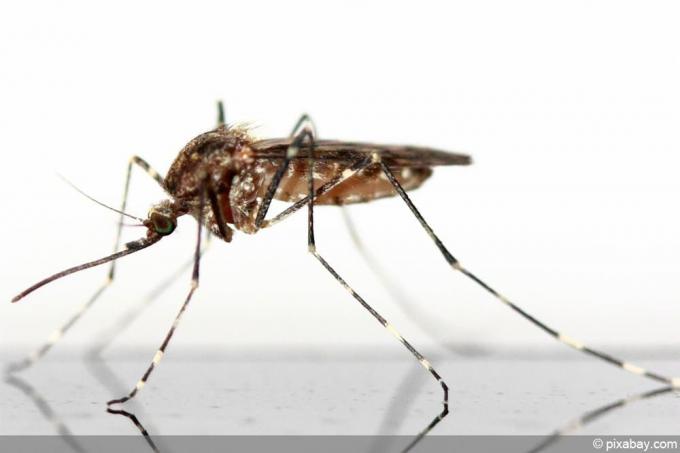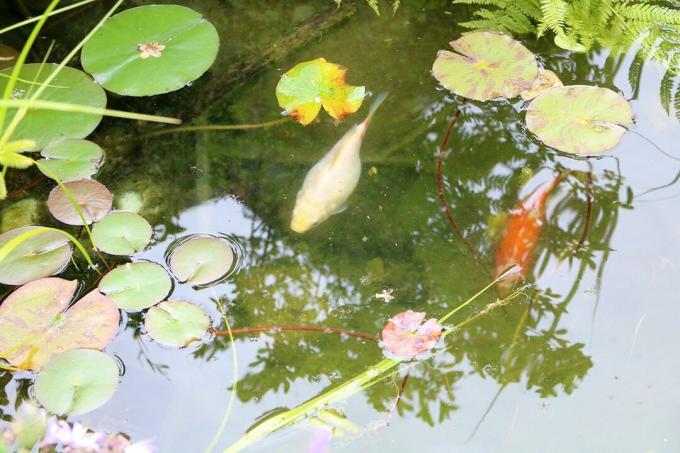

Table of contents
- Cause: mosquito larvae
- prevention
- skim off
- fly screen
- CO2 trap
- fight mosquito larvae
- fish
- surface tension
- Bacillus Thuringiensis Israelensis
- water hoses
- dragonflies
With their obtrusiveness and hunger for human blood, mosquitoes (Culicidae) are probably the most unpleasant visitors to your home garden. They prefer stagnant water to lay their eggs and can therefore reproduce in large numbers without any problems and make the summer at the garden pond a real torture. In order to still be able to relax and enjoy the splashing of the water, you should fight the mosquito larvae.
Cause: mosquito larvae
A mosquito plague develops over a period of several weeks as long as the animals have enough breeding places available. Unfortunately, there are many of these in German gardens, as they offer water features in abundance. Rain barrels in particular are a favorite of the Culicidae, they are a safe and undisturbed environment for the larvae. But the garden pond is also extremely popular and is an effective breeding ground for insects if the following properties exist:
- Water surface is undisturbed
- Water temperatures from about 15°C
The water quality is unimportant for the animals and they can actually use any form of pond as a breeding ground. Regardless of whether it is a Japanese ornamental pond filled with clear water or a tiny natural pond, the mosquito larvae can survive anywhere. The female mosquitoes lay several hundred eggs on the water surface, until the clearly visible ones Larvae hatch and remain upside down in the same spot in the garden pond for about three to four weeks stop. After this time, the cycle starts all over again, but you can protect your pond efficiently from infestation.
Tip:
Mosquito eggs can even survive the winter. They are placed in moist soil and the thawing water and warming in spring then take care of this for the first annoying swarms of mosquitoes, which sometimes even appear during particularly mild winter months can.
prevention
Before you have to resort to all sorts of remedies, it is advisable to efficiently prevent mosquitoes from breeding. This means you have to equip your pond in such a way that the pests are deprived of breeding grounds, which severely limits the population. Although not all mosquito larvae can always be prevented, there are far fewer than usual. The following methods are recommended for this:
skim off
Skimming off the mosquito larvae is quick and easy and enables the targeted minimization of the possible population. Since the larvae remain on the surface for some time after hatching, you can simply skim them off with a fine-mesh net and dispose of them in a dry plastic bag. You can recognize the mosquito larvae by the following characteristics:
- small, black larvae in the water
- move in twitching motions
- hang upside down
- flee when the water is disturbed
To do this, simply dip the net into the garden pond and walk once along the surface to catch a large number of mosquito larvae. Of course, pay attention to the other pond inhabitants and plants. Depending on the size of the pond, this process can take a long time, but it can collect numerous mosquito larvae.
Tip:
You can use the caught larvae as feed for aquarium fish. Simply add these to the aquarium in small quantities.
fly screen

Fly screens can be used not only for the apartment, but also for the garden pond. While this is not an ideal solution, especially if you have other pond inhabitants such as fish, the mosquitoes cannot lay eggs if they cannot reach the water. Choose a fine-mesh fly screen for this, through which the mosquitoes cannot get through. In addition, the fly screen should be UV-resistant, as it is constantly exposed to the sun. It could become brittle, resulting in small tears that the bloodsuckers could get through. This method is best used on extremely warm days.
CO2 trap
With a CO2 trap you can capture and kill numerous mosquitoes before they even reach your garden pond. The fully automated trap works as follows:
- the trap is set up in the immediate vicinity of the garden pond
- it is connected to a standard CO2 gas cylinder and switched on
- the machine emits CO2 and attractants that attract mosquitoes
- they then fly close to the machine, are sucked in and killed
- no other insects are killed, such as butterflies or bees, since the suction mechanism is designed for the mosquitoes
Although the machine is not directly effective against mosquito larvae, the mosquito population is permanently reduced because the adult animals are killed.
fight mosquito larvae
If you are constantly plagued by mosquitoes that use your garden pond as a breeding ground, you should fight them directly as soon as the preventive measures are no longer sufficient. Especially in warm, humid areas, the buzzing vampires multiply at record speed and these measures often do not help. Then only measures remain that directly take care of the mosquito larvae and fight them permanently.
fish
It is particularly easy to get rid of your larval plague if you bring fish into the pond. Numerous species prefer to feed on the mosquito larvae and even large populations can be tackled with the right species of fish. Of course, when making your selection, you must consider choosing species that stay small and will fit in your pond. The smaller your pond is, the smaller the corresponding fish must be so that they can be kept in a species-appropriate manner. The best mosquito hunters therefore include:
- goldfish
- gold orf
- moldies
- minnows
- rudd
- roach

Basically, you can use any fish that interests you, but they have to be omnivorous or carnivorous in order for them to be interested in the larvae at all. Once you have decided on a species, you can either find it in specialist shops or the pet store and release it in the pond. An advantage of this measure: with high mosquito populations, the larvae are often sufficient as food for the fish.
surface tension
Mosquito larvae need a calm water surface to thrive, which you can use to your advantage. But it is not enough here if you walk your hand through the pond several times a day, there must be constant movement. Even if only small parts of the pond are completely calm, the mosquitoes can use this space to lay eggs. Here you can help yourself with either a fountain or fountains, as these constantly move the water and break the surface tension.
Bacillus Thuringiensis Israelensis
Bacillus thuringiensis israelensis is a non-hazardous biocide that has proven itself in the fight against mosquito larvae for years. The Israeli researcher Joel Margalit discovered this bacterium in the 70s and it is a particularly good remedy against the larvae. A big advantage of the bacterium is its specialization on mosquito larvae. Other pond inhabitants are not harmed by the agent and even one tablet is sufficient for a garden pond with around 1,000 liters of water. The following products are recommended:
- Neudorff Neudomuck
- Culinex Tab plus
When using, follow the manufacturer's instructions to avoid using too much or too little of the bacterium.
water hoses
The water hoses are an interesting method of fighting mosquito larvae in the garden pond. At the water hoses (bot. Utricularia) is the most species-rich carnivore group and they have a ravenous appetite for the annoying pests. They feed on organisms that live in the water and in doing so, they have developed an effective system to get their prey:
- Plant forms long shoots in the water
- it swims in the water and does not settle on the bottom
- the shoots develop leaves with small air bubbles between them
- the vesicles act as a trap for mosquito larvae and other small organisms
- if the larvae are caught by the water hoses, they can no longer escape and are "consumed"
Water hoses are rigorous in this task and within a short time, the population of mosquito larvae is reduced many times over. You need between four and six plants for one square meter, which with enough food with their yellow Blossoms protruding from the water and, in addition to their activity as "predators", also a pretty accent in the pond represent.
dragonflies
It pays to include plants in your pond that attract dragonflies. Dragonflies feed exclusively on other creatures and water larvae are also part of the menu. For this reason, you should consider putting one or the other plant in the pond so that dragonflies can settle there. These plants include:
- Hornwort (bot. Ceratophyllum submersum)
- Eared watermila (bot. Myriophyllum spicatum)
In addition, the pond should not be deeper than 20 centimeters and should not contain any fish, since dragonflies also eat fish. The dragonflies offer themselves as an environmentally friendly method.
 garden editorial
garden editorial I write about everything that interests me in my garden.
Find out more about animals in the garden pond

22 small pond fish | Fish for small pond
Only a small pond fits in small gardens. But Mother Nature has also created a few little fish for these mini ponds. To be more precise, even several interesting species, which are not inferior in beauty to the large specimens. But be amazed!

7 Fish Diseases | Help for pond fish
For many an animal lover, their fish mean everything. The concern is correspondingly great when the animals suddenly behave in a strange way or show external symptoms of one of the numerous pond fish diseases. This guide explains how the owner makes an exact diagnosis, what causes it and what to do in this case.

Overwintering pond mussels | 14 tips for pond mussels in winter
Pond mussels are practical animals for the garden pond, as they can filter and thus clean the water. Their main food source is algae. But what happens to the pond mussel in winter when the water surface freezes over? Here we reveal how overwintering is possible.

Orfe in the garden pond | 10 tips for keeping & propagation
The water has been filled in, the green planting is in place. Now a color contrast and movement in the garden pond are still missing. A swarm of gold orfs can provide both. Yellow-orange in colour, they are clearly circling in the water. When do you feel comfortable in it?

Frog in the pond: what do frogs eat in the garden pond?
Frogs in the pond are important beneficial insects because they devour numerous annoying pests. Frogs are good and patient hunters, able to ambush prey for a long time. The more diverse the pond is designed, the greater the food supply, which attracts different species.

Sturgeon in the garden pond | 10 tips for keeping in the pond
Would you like to enrich your pond with a real sturgeon? The desire for such a striking animal is easy to understand. Our tips on how to handle this living fossil will help you ensure that keeping is always successful.

